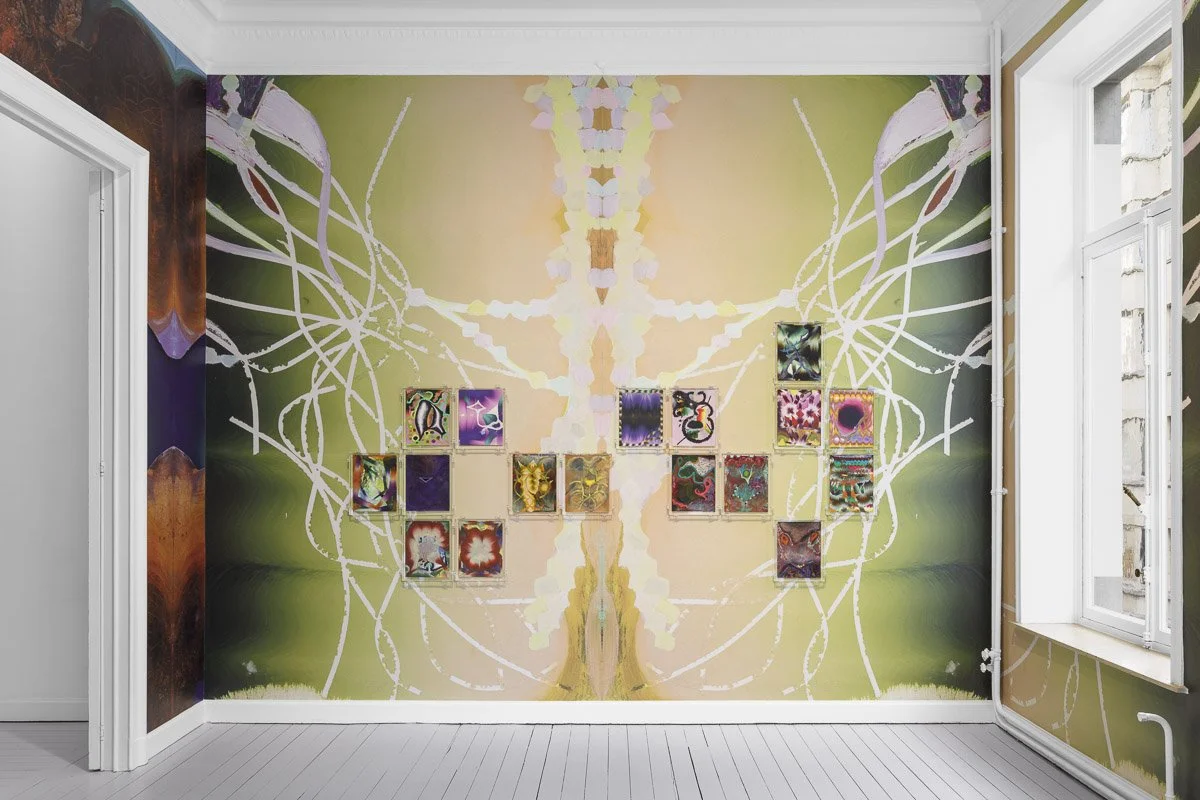KERSTIN BRÄTSCH: MƎTA
Kerstin Brätsch presents MƎTA, an exhibition of new paintings and wallpapers for her inaugural exhibition at Gladstone in Brussels. Expanding upon her Psychics and Para Psychics project from 2022, Brätsch’s abstract compositions employ her painterly practice to probe the body’s psychological, psychical, and social expressions.
January 22 – April 26, 2025
In Brussels, a good one hundred years ago, artists of symbolist conviction took integration out of their own times. With no intention of representing the shapes of their present, their art was taking themselves out of it. Integrating away. This was never meant to be obscure. It was destined to be popular. Robert Pincus-Witten was struck by it in the late 1960s, by the Salon de la Rose & Croix in Paris, into which Fernand Khnopff and Félicien Rops exported their work: 10.000 people came to its first opening, 274 carriages drove up, 22.600 people would see the show. Eric Satié had composed fanfares. A perfumist gave the exposition its scent. A florist positioned lilies within it. In the late 1960s Pincus-Witten did a lot of things. He coined Postminimalism. It is the build-out of the present, not its critique, that he sees Symbolists and Postminimalists aligned in. Integrating out.
In Berlin, a good one hundred years ago, Lu Märten wrote the story of elfes who tell a child to become a poet, materializing past generations’ dreams. Not unsymbolist at all. Not even a tiny bit. In unison, Märten, a convicted materialist, wrote about the devastating “underconsumption” of art in her time. As artists are workers of “the head, the heart and the hand” their labor of integration isolates them out of a world built on the separation of their trinity. It renders them a “desocialized social being”, delivers them to “artist misery”, their state of the arts, still. Today. Integration is Märten seeking to bring art into general consumption: “That the walls of all life remain empty, while thousands of hands are working for them”, is limiting representations into ideals. Fancy. The “artistic misery” of luxuriating scarcity has to stop, the integration of art into schools, hospitals, administrations, cafés, hotels, should undo it and recalibrate the “personal reagent of the individual”. Chemical integrations.
In Zurich, a good one hundred years ago, Hermann Rorschach introduced the psychodiagnostics test of his name. Eugène and Françoise Minkowska popularized it in Paris a bit later, a non-illustrated publication followed in 1947. Like Rorschach, they studied with Eugen Bleuler, unlike him, they were really into Henri Bergson. Sarah Wilson writes that the artistic “craze” for Rorschach’s test did extend well beyond Henri Michaux. That Gaston Ferdière, the psychiatrist who treated Antonin Artaud, and orchestrated large, Salon de la Rose & Croix-scale, shows of surrealist with psychiatrist artists in Paris in the 1940s, talked forty to fifty illustrious personalities of the Saint Germain-des-Près milieu into taking the test with him. Psychiatric patients’ works of integration and surrealist professionals’ work of representation were aligned on a sliding scale of a fantastic real. That art wanted to leave its representations so very badly. Not bad enough to let art (just) be a test though.
Meta is here to integrate. Like Brussels, like Berlin, like Paris, it offers a sliding scale (out) of art into (more) consequential consumptions. Brätsch tests: interpretations of bodies she found in esoteric sense/s, abstractions that broke out of bodies she painted, aided by blowing them up for inspection, aided by giving them an order of appearance, aided by systems of esoteric representation. Exotericism has proven to leave art weirded out, underconsumed and unconscious.


